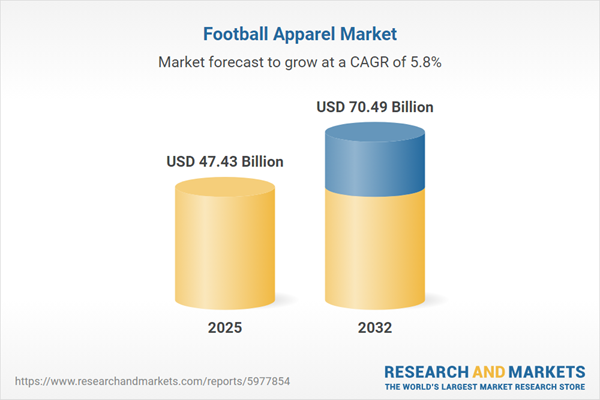Speak directly to the analyst to clarify any post sales queries you may have.
Senior leaders in the football apparel market are navigating complex shifts driven by changing regulations, sustainability mandates, and rapid technological development. In this evolving sector, effective, timely intelligence is critical for informed strategic planning and maintaining a competitive edge.
Market Snapshot: Football Apparel Market Size and Trajectory
The football apparel market is demonstrating strong momentum on a global scale. In 2024, valuation stands at USD 44.76 billion, with forecasts of continued growth to USD 47.43 billion in 2025 and notable expansion reaching USD 70.49 billion by 2032. This positive trajectory reflects the effects of growing international football participation, increased sustainability awareness among consumers, and shifting preferences towards apparel that offers both functional performance and ethical production. For senior executives, understanding the pace and scale of this expansion is vital for making strategic investments and positioning for long-term growth within a highly competitive landscape.
Scope & Segmentation of the Global Football Apparel Market
A comprehensive segmentation provides the foundation for data-driven decision-making as market complexity intensifies. This section outlines vital categories and regional focuses senior leaders should evaluate to anticipate and respond rapidly to industry shifts.
- Material: Analysis spans traditional natural fibers, advanced performance polymers, and the integration of recycled textiles. This focus supports targeted development of comfort-centric and sustainability-compliant products that address rising regulatory demands.
- Gender: Inclusive coverage of men's, women’s, and unisex products enables strategies for expanded market reach and supports building diverse product portfolios that capture evolving consumer expectations.
- Product Type: Assesses training apparel, match kits, protective equipment, and accessories, highlighting pathways for portfolio diversification and customization for distinct user groups, from elite athletes to casual players.
- Distribution Channel: Reviews sports-specialist retail, broadline retail, e-commerce, and direct-to-consumer models. This analysis assists in optimizing channel strategies for stronger geographic and demographic coverage, especially as digital platforms and consumer journeys become more interconnected.
- Regional Coverage: Provides insight into North America, Latin America, Europe, the Middle East, Africa, and Asia-Pacific. Regional evaluation includes regulatory environments, consumer drivers, and unique logistical or compliance challenges that may impact time-to-market and strategic localization.
- Company Landscape: Benchmarks established players—Nike, adidas, Puma, Under Armour, New Balance, Umbro, Mizuno, Kappa, Joma Sport, Castore—offering an understanding of innovation and differentiation, especially in textile advancements and environmental initiatives.
Key Takeaways for Senior Decision-Makers
- Adopting new textile technologies that enhance moisture management and breathability allows brands to better meet the evolving expectations of both professional athletes and recreational users.
- Prioritizing responsible sourcing, such as scaling up recycled materials, strategically positions brands to meet or exceed emerging regulatory requirements while resonating with environmentally conscious consumers.
- Leveraging digital customization enables the creation of personalized experiences, supporting enhanced consumer engagement and deeper brand loyalty in existing and emerging markets.
- Blending performance-focused attributes with lifestyle-inspired design allows companies to extend their appeal across age groups and supports ventures into adjacent sectors through collaborations.
- Implementing unified omnichannel solutions improves consistency across the customer journey, ensuring a seamless transition between online and physical retail environments and optimizing sales opportunities.
- Collaborative relationships with technology suppliers accelerate the adoption of innovative materials and ensure readiness for new safety and compliance standards, which is critical amid rapid regulatory change.
Tariff Impact on Football Apparel Market Dynamics
Recent tariff fluctuations, particularly in the United States, are prompting organizations to rethink sourcing strategies and supply chain models. Senior leaders are emphasizing the diversification of supplier networks, evaluating nearshore alternatives, and strengthening risk analysis capabilities. These steps help manage cost structures and maintain operational continuity despite ongoing policy uncertainty.
Methodology & Data Sources
Market intelligence in this report is assembled using insights from executive stakeholders, direct site visits at key production points, and in-depth analysis of regulatory as well as supply chain data. Robust benchmarking and systematic data validation processes ensure findings are reliable and directly applicable to business planning.
Why This Report Matters for Senior Football Apparel Leaders
- Helps drive innovation by clarifying channel approaches, supporting market diversification, and ensuring adaptability in light of shifting consumer and regulatory trends.
- Provides actionable strategies for building resilient supply chains and advancing goals in technology adoption and sustainability across diverse global regions.
- Supports leadership teams in optimizing resource allocations and bolstering risk management frameworks in a market characterized by evolving standards and shifting customer focuses.
Conclusion
This report delivers focused insights and practical guidance to empower senior executives in the football apparel sector. Leaders can leverage its findings to strengthen operational agility and pursue sustainable growth strategies in an increasingly dynamic industry environment.
Additional Product Information:
- Purchase of this report includes 1 year online access with quarterly updates.
- This report can be updated on request. Please contact our Customer Experience team using the Ask a Question widget on our website.
Table of Contents
3. Executive Summary
4. Market Overview
7. Cumulative Impact of Artificial Intelligence 2025
Companies Mentioned
The companies profiled in this Football Apparel market report include:- Nike, Inc.
- adidas AG
- Puma SE
- Under Armour, Inc.
- New Balance Athletics, Inc.
- Umbro International Limited
- Mizuno Corporation
- Kappa S.p.A.
- Joma Sport, S.A.
- Castore International Limited
Table Information
| Report Attribute | Details |
|---|---|
| No. of Pages | 190 |
| Published | October 2025 |
| Forecast Period | 2025 - 2032 |
| Estimated Market Value ( USD | $ 47.43 Billion |
| Forecasted Market Value ( USD | $ 70.49 Billion |
| Compound Annual Growth Rate | 5.8% |
| Regions Covered | Global |
| No. of Companies Mentioned | 11 |









